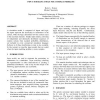Free Online Productivity Tools
i2Speak
i2Symbol
i2OCR
iTex2Img
iWeb2Print
iWeb2Shot
i2Type
iPdf2Split
iPdf2Merge
i2Bopomofo
i2Arabic
i2Style
i2Image
i2PDF
iLatex2Rtf
Sci2ools
WSC
1998
1998
Input Modeling Tools for Complex Problems
A simulation model is composed of inputs and logic; the inputs represent the uncertainty or randomness in the system, while the logic determines how the system reacts to the uncertain elements. Simple input models, consisting of independent and identically distributed sequences of random variates from standard probability distributions, are included in every commercial simulation language. Software to fit these distributions to data is also available. In this tutorial we describe input models that are useful when the input modeling problem is more complex.
Input Models | Modeling And Simulation | Simple Input Models | Standard Probability Distributions | WSC 1998 |
| Added | 01 Nov 2010 |
| Updated | 01 Nov 2010 |
| Type | Conference |
| Year | 1998 |
| Where | WSC |
| Authors | Barry L. Nelson, Michael Yamnitsky |
Comments (0)

